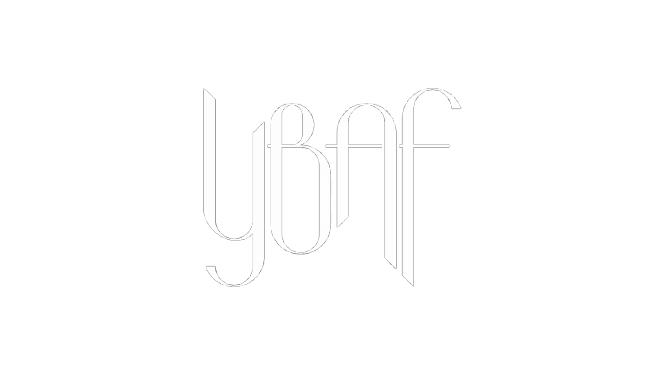Past Exhibition | October 9–12, 2021
In…Divided
Back in October 2021, Yerevan bore witness to something rare—raw, experimental, and deeply collaborative.
For two months, Latitude Art Space transformed into a shared studio for six Armenian artists as part of the YBAF Artist Collective Residency Program. Six artists, six distinct voices—each claiming a part of the space while navigating the tension between division and coexistence. This dynamic residency culminated in a powerful collective exhibition titled “In…Divided”, which opened on October 9 and closed just three days later, leaving a permanent mark on those who stepped into its layered world.
The space itself was the stage: no white-cube detachment, no sterilized presentation. The final works stood exactly where they had been born—among conversations, coffee cups, sketch drafts, and the silent rituals of making. Visitors became voyeurs of the creative process itself.
Meri Karapetyan
In In…Divided, Meri Karapetyan left a powerful mark with a haunting artwork created on authentic wartime paper from 1945 — the same material once used to shield windows during WWII. On its fragile surface, she painted barbed wire, evoking the violence of war and the psychological borders it creates. Her piece wasn’t just visual; it was visceral. A meditation on memory, trauma, and territory, Meri’s work reminded us that paper may be thin, but history weighs heavy on it. Her painterly language carries echoes of architectural logic and French modernist sensibility, which she continues to explore through her academic path at Sorbonne.
Sasun Margaryan
Sculptor Sasun Margaryan contributed a deeply personal and raw piece to the exhibition — a sculpture titled Let Me Hold You, made from a war fragment. It was born out of the 44-day Artsakh war in 2020, embodying both ruin and tenderness. The jagged material, once a weapon, was transformed into a tender gesture — two small arms reaching out, aching to embrace. Sasun, currently pursuing his MA in sculpture at the State Academy of Fine Arts, reminds us that even in destruction, there’s a yearning for love. Stone is his medium, but emotion is his true material.
Hakop Vardanyan
Hakop Vardanyan brought classical technique and quiet intensity into the collective mix. A sculptor with roots in the Yerevan Academy of Fine Arts and a member of the Union of Armenian Artists of the World, Hakop turned his residency studio into a sanctuary of form and focus. His works in the show reflected a mastery of physicality, rendering material with a sense of ritual. Each sculpture was a frozen moment — patient, strong, and deeply human. Hakop’s presence at Latitude offered balance to the chaos of experimentation around him.
Gohar Sargsyan
In her series Land–Escape, Gohar Sargsyan invited us to contemplate absence. Her paintings were not merely landscapes but elegies to the land itself — stripped of people, but heavy with the memory of their passage. Gohar captured the paradox of presence in absence, where nature becomes a silent archive of human activity. Her brushstrokes evoke the invisible scars of exploitation, yet within them, a quiet hope flickers: the possibility of reconnection. In the space she occupied, Gohar cultivated a calm resistance — painting not to escape reality, but to face it more clearly.
Nare Petrossian
Nare Petrossian surprised us all with Body Parts — an experimental project where she used her own body as a printing tool. Abandoning traditional brushes, Nare turned her elbows, feet, and even face into instruments of expression. Each print was a gesture of liberation, a playful rebellion against the confines of academic art. Her approach was raw, immediate, and deeply personal — a rediscovery of self through contact with the canvas. For Nare, art isn’t just something she creates; it’s something she inhabits. And during the residency, she did just that — fully, boldly, and unapologetically.
Ani Chopuryan
Designer Ani Chopuryan brought a sharp eye for composition and material flow to the exhibition. Her works blurred the lines between functional design and fine art, often transforming everyday objects into meditative structures. In the shared space of the residency, Ani's work acted like connective tissue — harmonizing the contrasting voices of the other artists. With an intuitive grasp of balance, she reminded us that beauty can emerge not despite limitations, but because of them. Ani’s contributions grounded the exhibition, offering visual clarity amid conceptual complexity.
Though divided by space and medium, the six were united in one critical question: Do the limitations of coexistence diminish individuality, or do they reveal something essential about it?
This question echoed through the exhibition like a chorus—complex, layered, sometimes dissonant, but always sincere.
“When a show is collective, it becomes a choir,” noted YBAF Director Ella Kanegaryan. “People don't speak to each other or above each other, they speak at once. And in that simultaneity, we sometimes find something closer to truth.”
The exhibition was supported by Schweppes, which purchased one of the artworks at the show’s close—an act both symbolic and material, as the proceeds were shared among the artists.
